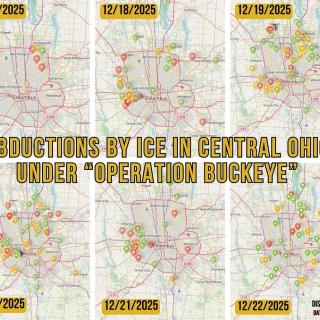President Donald Trump will hold his first 2020 presidential campaign rally in Ohio on January 9 at a “Keep America Great” event in Toledo. On December 16, 2019, Trump filed to be on the ballot in Ohio, unopposed by any other Republican candidates.
Pundits mid-year were skeptical that Ohio would be a battleground state in 2020, but a CNN article recently proclaimed that: “To win reelection, Trump needs Ohio.”
Ohio voted for Trump in 2016, winning by eight points. Believing his populist rhetoric slamming “the swamp” in D.C. and declarations that he’d fight for the working guy, scores of voters rejected Hilary Clinton and so-called “liberalism.” In 2016, Trump won 80 out of 88 Ohio counties, including nine that voted for Obama in 2012.
Now these voters have the opportunity to re-elect their leader – but will they buy the hype again?
Some voters reported that they liked Trump in 2016 because “Finally, somebody thinks like me,” according to the Washington Post.
Maybe they hate the entrenched politicians who are out of touch with everyday people’s reality. But Trump has done the opposite of draining the swamp. He’s retained corrupt Washington insiders and appointed legendary political hacks like Rudy Giuliani and convicted criminals like Elliott Abrams in his administration.
Maybe they agree with Trump that immigrants are a big problem in this country. But building a wall is not a policy solution. Wall or not, working Ohioans will still struggle to make a livable wage, rent a decent apartment, pay medical expenses, afford tuition and feed their families.
Maybe they just distrust “liberals” because, well, they’re liberal. News flash: Liberals care about working people. Liberal and left-wing policies benefit working people.
Voters making over $50,000 still approve of Trump. Why? His policies benefit rich people. How many of the uber-rich have enough compassion to realize his policies may also adversely affect the majority of the population, the rest of the world, and the planet?
Many MAGA fanatics are reconsidering. Since Trump took office, his net approval rate in Ohio has decreased by 19 percentage points, says Morning Consult, a website that does a daily poll of 5000 registered voters.
Many of Trump voters’ opinions aren’t based on facts, just on perception. Trump lies, the media promotes the lies, but things stay bad or get worse for working people.
For example, touting the Toledo campaign kick-off rally, Trump’s Chief Operating Officer Michael Glassner announced that “President Trump is delivering on his promises and looks forward to celebrating those successes with the great men and women in Ohio.”
What successes? Did Trump follow through on any of his promises?
Here’s how working Ohioans fare with the basic necessities of life under Trump.
Earning a living:
Trump promised to bring back manufacturing jobs. Glassner stated that Ohio has added 94,700 new jobs including 14,700 manufacturing jobs. He didn’t mention how much they paid.
Ohio is ranked 37th in job creation, according to the New York Times. Ohio was listed as a swing state with no projected growth. Midwestern swing states such as Ohio, Michigan, Wisconsin, Pennsylvania and Minnesota are all clustered at the bottom of Trump’s “job creation” initiative.
Most economic predictions are that midwestern states, key to Trump’s unexpected 2016 victory, are likely to see an economic downturn in 2020. Ohio’s economy is projected to stagnate, meaning fewer new businesses will open and more people will be laid off, according to data from the Federal Reserve Bank of Philadelphia.
One of Trump’s re-election problems is that “growth is uneven,” according to the Federal Bureau of Economic Analysis. The liberal think tank Policy Matters Ohio noted that Ohio jobs "have grown at just 0.4 percent over the last 12 months, compared to the national average of 1.4 percent. Ohio employers are adding jobs half as fast as they did in 2018, one of the worst years for job growth since the end of the 2007 recession.
In typical Trumpian fashion, the president declared in a Tweet about the projected 1.9 percent growth that the economy is “BOOMING.” Back in 2012 when Obama faced a similar 1.9 percent growth rate, Trump then noted that the economy was in “deep trouble.”
Nine out of the ten most common jobs in Ohio pay less than $34,000.00 a year. This accounts for over a million workers in the state, according to the Bureau of Labor Statistics in 2018.
The median wage for working Ohioans is not enough to support a family, says Policy Matters Ohio. The median average salary for a food prep job is $19,360.00. Ninety-three percent of food prep workers with a family of three live in poverty. Cashiers don’t earn much more at $20,190, retail sales clerks average $23,010, and stock clerks/order fillers bring in $24,880.00. Only nurses are paid a living wage.
Ohio’s 4.2 percent unemployment rate is higher than the national average at 3.5 percent, stated cleveland.com. Though the media proclaims the economy is doing well, one thousand Ohioans applied for unemployment this past November.
On September 24 this year, Trump’s Department of Labor issued an “Overtime Rule.” Trump’s new rule weakens the previous one from the Obama administration. Obama’s rule boosted the pay of 370,000 Ohioans. Under Trump’s rule, 230,000 Ohio workers will lose $85 million in wages a year because salaried workers making more than $35,568 a year will not receive overtime.
“Workplace protections like the minimum wage and overtime, as well as key benefits like health insurance and pensions, are built on the basic assumption of a full-time job with an employer. As that relationship crumbles, millions of hardworking Americans find themselves ejected from that implicit pact,” Politico wrote in February 2018.
Earning a living selling U.S. goods
Another Trump promise was to impose tariffs on goods made in China and Mexico. He made good on this one, to his detriment. Swing states and swing counties within those states have been hit the hardest by Trump’s trade war. “Most of these counties have lost manufacturing jobs in 2019,” according to the New York Times.
Northeast industrial Ohioans are not going to forget Trump’s words when he promised that the manufacturing jobs are “all coming back.” This could become one of the most famous lies in presidential campaign politics, equivalent to the infamous assertion by George Herbert Walker Bush to “Read my lips. No new taxes.” (GM) discontinued the Chevy Cruze in March 2019, approximately 4500 Lordstown workers on three shifts lost their jobs. Only one thousand were relocated to other GM plants.
GM Chief Executive Officer Mary Barra blamed the plant closing on the fact that the company lost $1 billion due to Trump’s tariffs on steel and aluminum, Politico reported. Trump’s responded to the plant closing by attacking the union president, asserting he “ought to get his act together and produce.”
CNBC reported that Chris Gibbs, former Chairperson of the Shelby County, Ohio Republican Party, announced that he won’t vote for Trump in 2020 because of his agricultural trade policy. China made $19.1 billion in U.S. agricultural purchases in 2017. After Trump stirred up a trade war, the number fell by more than half in 2018, according to the American Farm Bureau – far short of the $40-50 billion Trump promised.
Renting:
Of the ten most common jobs in Ohio, only three pay enough to afford a two-bedroom apartment at $1000 a month, reports the National Low Income Housing Coalition and the Coalition on Homelessness and Housing in Ohio. The average hourly wage needed to rent a two-bedroom is $15.73/hour in Ohio. But Columbus has the highest housing costs in the state. To rent a two-bedroom in Columbus, not spending over 30 percent of total monthly income, a wage of $17.50/hour is necessary.
Staying healthy:
Trump promised a “Full repeal of Obamacare” and a replacement with a market-based alternative. Ohio is one of eight states to see the number of uninsured people increase under Trump, for the first time since 2009, reported Cleveland.com in September 2019. Getting alternatives is not easy. Trump cut all funding for northeast Ohio’s Navigator program, that helps people understand and enroll in Medicaid and the Affordable Care Act (ACA). He also slashed the national ACA advertising budget by 90 percent, making it even harder to enroll.
Eating:
Trump’s 2020 budget stripped $1.9 trillion from social welfare spending for low- and middle-income people. Cleveland.com warned that: “President Donald Trump’s tightening of requirements to receive food stamps is coming just as Ohio is about to launch new work requirements for Medicaid, potentially tossing thousands of poor Ohioans off one or both safety net programs.” Trump’s Supplemental Nutrition Assistance Program (SNAP) work requirement rules will negatively affect 61,000 households in Ohio. New Trump eligibility rules may also affect children’s school breakfast and lunch programs, stated Lisa Hamler-Fugitt, executive director of the Ohio Association of Foodbanks.
What’s the Outlook for 2020?
Historically, the axiom asserted: as goes Ohio, so goes the nation. The assumption is that Trump must win Ohio to secure the necessary 270 electoral votes to win in 2020.
In 2016, Trump won by miniscule margins in Michigan, Wisconsin and Pennsylvania – although all exit polls indicated that Clinton was the actual victor. The last time Michigan voted in a Republican president was Reagan in 1984. Trump’s combined vote total in those critical states was only 77,744 votes.
CNN suggests that two reasons Trump could potentially lose the Midwest states this year would be a national recession coupled with mass defection by suburban white women, due to his abrasive behavior.
Public Policy Polling and Innovation Ohio conducted an October poll that predicts 2020 will find Ohio returning to its battleground state status. Their analysis indicates President Trump losing to a generic Democratic by 47-48 percent and that a majority of Ohioans rate his administration as unfavorable. The poll also tested President Trump against five Democratic candidates and “he failed to top 47 percent against any of them.”
CNN interviewed Montgomery County, Ohio voters the day before the Otterbein College Democratic primary debate in October. The interviews “…suggest signs of electoral trouble for the commander-in-chief….in nearly two-dozen interviews, voters here – particularly independents – expressed growing unease about Trump's actions, from his attempt to enlist help from Ukraine's president to investigate his political rival to his abrupt decision to abandon a key US ally in Syria….” Voters felt uneasy about Trump’s decision-making ability, his attempt to achieve “absolute power,” and his misogynism and sexual abuse of women.
Impeachment
Trump’s Toledo rally may possibly happen at the same time as the Senate impeachment hearings. An Emerson poll of Ohioans in October revealed that 47 percent of Ohio voters support impeachment with 43 percent opposed. Ten percent were unsure.
USA Today suggested that it’s not impeachment Trump should worry about: “Never mind impeachment, swing-state trade war and economic woes could doom Trump in 2020.”




